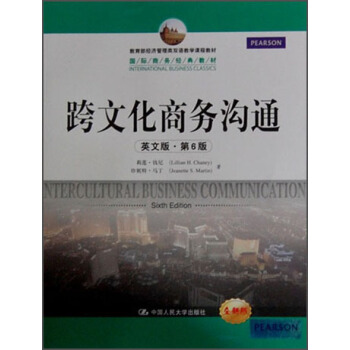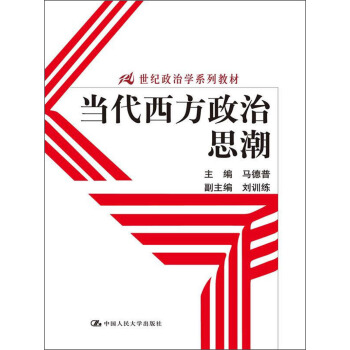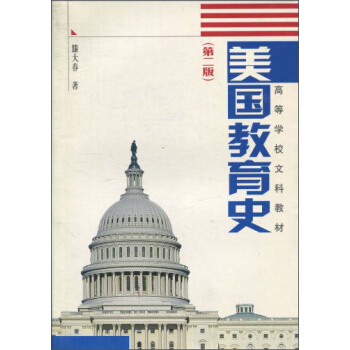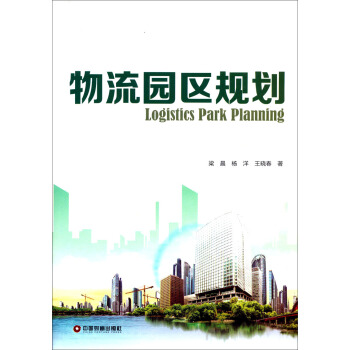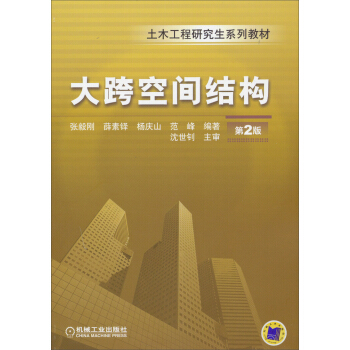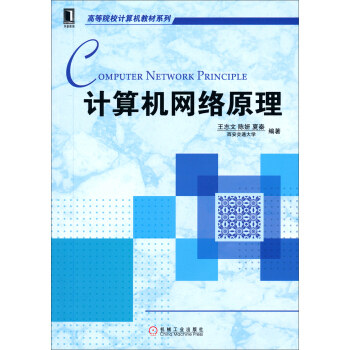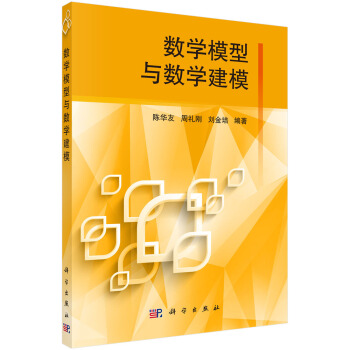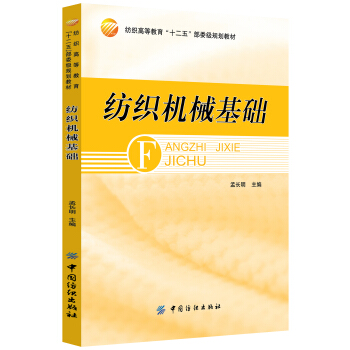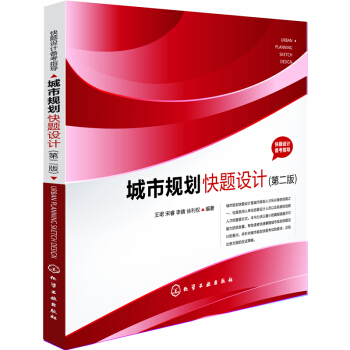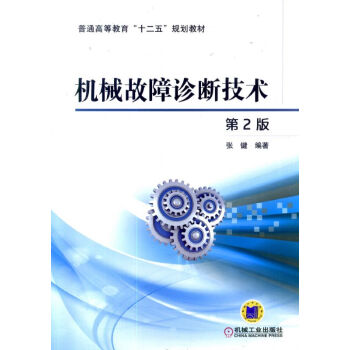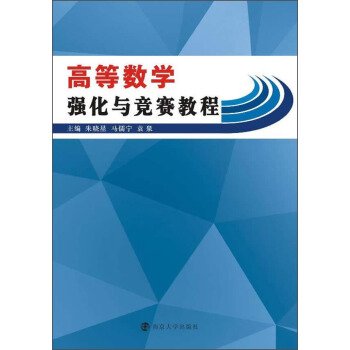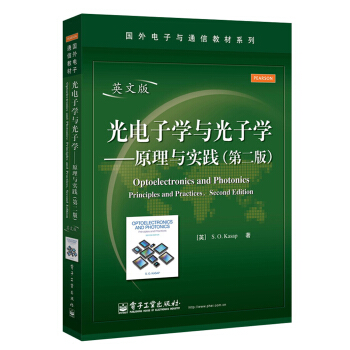

具體描述
編輯推薦
《國外電子與通信教材係列:光電子學與光子學·原理與實踐(第2版)(英文版)》是在光電子和光子器件領域的一個最新的適閤本科階段的入門教科書,《國外電子與通信教材係列:光電子學與光子學·原理與實踐(第2版)(英文版)》力求采用盡可能少的數學推導而強調通過物理概念來說明原理,提供瞭許多例題,使得課本概念與實際器件相聯係,也提供瞭大量的練習題。《國外電子與通信教材係列:光電子學與光子學·原理與實踐(第2版)(英文版)》有非常清楚的文字和圖,明確的解釋使得問題很容易理解。與眾不同的另一點是它既覆蓋瞭光子學基本麵,又具有較深的深度,包含瞭具體的器件設計和工程應用知識,將光子學和光電子基本理論與各種光子學應用相結閤。所以這是一本對本科生、研究生以及光電工程師都非常有用的教科書。
內容簡介
《國外電子與通信教材係列:光電子學與光子學·原理與實踐(第2版)(英文版)》的主要內容包括光的波動特性,介質波導和光縴,半導體科學基礎和LED,光放大器和激光器,光探測器和圖像傳感器,光的偏振和調製等。每個章節除瞭基本的題材,還給齣一些附加主題適當介紹先進技術和産品化光電子器件實例,擴大和深化讀者對基本內容的理解。《國外電子與通信教材係列:光電子學與光子學·原理與實踐(第2版)(英文版)》力求采用盡可能少的數學推導而強調通過物理概念來說明原理,提供瞭許多例題,使得課本概念與實際器件相聯係,也提供瞭大量的練習題。
作者簡介
S.O.Kasap,是加拿大薩斯喀徹溫大學(University of Saskatchewan)電氣工程係教授以及加拿大電子材料與器件首席科學傢(Canada Research Chair)。他於1976年、1978年和1983年在倫敦大學帝國理工學院(Imperial College of Science。Technology and Medicine,University of London)分彆獲得學士、碩士和博士學位。他的研究興趣涵蓋瞭光電子材料與器件的許多方麵,如光子晶體光縴布拉格光柵、光通信、醫療成像、半導體器件的電氣噪聲特性等。S.O.Kasap已在權威國際期刊發錶多篇論文。他還是英國電氣工程師學會(IEE)、英國物理學會和英國材料學會的會士。目前,他是Journal of Materials Science的副主編。目錄
Chapter 1 Wave Nature of Light1.1 Light Waves in a Homogeneous Medium
1.2 Refractive Index and Dispersion
1.3 Group Velocity and Group Index
1.4 Magnetic Field, Irradiance, and Poynting Vector
1.5 Snell's Law and Total Internal Reflection (TIR)
1.6 Fresnel's Equations
1.7 Antireflection Coatings and Dielectric Mirrors
1.8 Absorption of Light and Complex Refractive Index
1.9 Temporal and Spatial Coherence
1.10 Superposition and Interference of Waves
1.11 Multiple Interference and Optical Resonators
1.12 Diffraction Principles
1.13 Interferometers
1.14 Thin Film Optics: Multiple Reflections in Thin Films
1.15 Multiple Reflections in Plates and Incoherent Waves
1.16 Scattering of Light
1.17 Photonic Crystals
Chapter 2 Dielectric Waveguides and Optical Fibers
2.1 Symmetric Planar Dielectric Slab Waveguide
2.2 Modal and Waveguide Dispersion in Planar
2.3 Step-Index Optical Fiber
2.4 Numerical Aperture
2.5 Dispersion In Single-Mode Fibers
2.6 Dispersion Modified Fibers and Compensation
2.7 Bit Rate, Dispersion, and Electrical and Optical Bandwidth
2.8 The Graded Index (GRIN) Optical Fiber
2.9 Attenuation in Optical Fibers
2.10 Fiber Manufacture
2.11 Wavelength Division Multiplexing: WDM
2.12 Nonlinear Effects in Optical Fibers and DWDM
2.13 Bragg Fibers
2.14 Photonic Crystal Fibers-Holey Fibers
2.15 Fiber Bragg Gratings and Sensors
Chapter 3 Semiconductor Science and Light-Emitting Diodes
3.1 Review of Semiconductor Concepts and Energy Bands
3.2 Semiconductor Statistics
3.3 Extrinsic Semiconductors
3.4 Direct and Indirect Bandgap Semiconductors:
3.5 pn Junction Principles
3.6 pn Junction Reverse Current
3.7 pn Junction Dynamic Resistance and Capacitances
3.8 Recombination Lifetime
3.9 pn Junction Band Diagram
3.10 Heterojunctions
3.11 Light-Emitting Diodes: Principles
3.12 Quantum Well High Intensity LEDs
3.13 LED Materials and Structures
3.14 LED Efficiencies and Luminous Flux
3.15 Basic LED Characteristics
3.16 LEDs for Optical Fiber Communications
3.17 Phosphors and White LEDs
3.18 LED Electronics
Chapter 4 Stimulated Emission Devices: Optical Amplifiers and Lasers
4.1 Stimulated Emission, Photon Amplification, and Lasers
4.2 Stimulated Emission Rate and Emission Cross-Section
4.3 Erbium-Doped Fiber Amplifiers
4.4 Gas Lasers: The He-Ne Laser
4.5 The Output Spectrum of a Gas Laser
4.6 Laser Oscillations: Threshold Gain Coefficient
4.7 Broadening of the Optical Gain Curve and Linewidth
4.8 Pulsed Lasers: Q-Switching and Mode Locking
4.9 Principle of the Laser Diode
4.10 Heterostructure Laser Diodes
4.11 Quantum Well Devices
4.12 Elementary Laser Diode Characteristics
4.13 Steady State Semiconductor Rate Equations:
4.14 Single Frequency Semiconductor Lasers
4.15 Vertical Cavity Surface Emitting Lasers
4.16 Semiconductor Optical Amplifiers
4.17 Superluminescent and Resonant Cavity Leds:
4.18 Direct Modulation of Laser Diodes
4.19 Holography
Chapter 5 Photodetectors and Image Sensors
5.1 Principle of the pn Junction Photodiode
5.2 Shockley-Ramo Theorem and External Photocurrent
5.3 Absorption Coefficient and Photodetector Materials
5.4 Quantum Efficiency and Responsivity
5.5 The pin Photodiode
5.6 Avalanche Photodiode
5.7 Heterojunction Photodiodes
5.8 Schottky Junction Photodetector
5.9 Phototransistors
5.10 Photoconductive Detectors and Photoconductive
5.11 Basic Photodiode Circuits
5.12 Noise in Photodetectors
5.13 Image Sensors
5.14 Photovoltaic Devices: Solar Cells
Chapter 6 Polarization and Modulation of Light
6.1 Polarization
6.2 Light Propagation in an Anisotropic Medium:
6.3 Birefringent Optical Devices
6.4 Optical Activity and Circular Birefringence
6.5 Liquid Crystal Displays
6.6 Electro-Optic Effects
6.7 Integrated Optical Modulators
6.8 Acousto-Optic Modulator
6.9 Faraday Rotation and Optical Isolators
6.10 Nonlinear Optics and Second Harmonic Generation
6.11 Jones Vectors
……
前言/序言
PrefaceThe first edition of this book was written more than 12 years ago. At the time it was meant as an easy-to-read book for third-year engineering or applied physics undergraduate students;it emphasized qualitative explanations and relied heavily on intuitive derivations. As things turned out, the first edition ended up being used in fourth-year elective classes, and even in graduate courses on optoelectronics. Many of the instructors teaching at that level rightly needed better derivations, more rigor, better explanations, and, of course, many more topics and problems. We have all at one time or another suffered from how wrong some intuitive short-cut derivations can be. The second edition was therefore prepared by essentially rewriting the text almost from scratch with much better rigor and explanations, but without necessarily dwelling on mathematical details. Many new exciting practical examples have been introduced, and numerous new problems have been added. The book also had to be totally modernized given that much had happened in the intervening 12 years that deserved being covered in an undergraduate course.
Features, Changes, and Revisions in the Second Edition
The second edition represents a total revision of the first edition, with numerous additional features and enhancements.
All chapters have been totally revised and extended.
Numerous modern topics in photonics have been added to all the chapters.
There are Additional Topics that can be covered in more advanced courses, or in courses that run over two semesters.
There are many more new examples and solved prblems within chapters, and many more practical end-of-chapter problems that start from basic concepts and build up onto advanced applications.
Nearly all the illustrations and artwork in the first edition have been revised and redrawn to better reflect the concepts.
Numerous new illustrations have been added to convey the concepts as clearly as possible.
Photographs have been added, where appropriate, to enhance the readability of the book and to illustrate typical modern photonic/optoelectronic devices.
The previous edition’s Chapter 7 on photovoltaics has been incorporated into this edition’s Chapter 5 as an Additional Topic, thus allowing more photonics-related topics to be covered.
Advanced or complicated mathematical derivations are avoided and, instead, the emphasis is placed on concepts and engineering applications.
Useful and essential equations in photonics are given with explanations and are used in examples and problems to give the student a sense of what typical values are.
Cross referencing in the second edition has been avoided as much as possible, without too much repetition, to allow various sections and chapters to be skipped as desired by the reader.
There is greater emphasis on practical or engineering examples; care has been taken to consider various photonics/optoelectronics courses at the undergraduate level across major universities.
The second edition is supported by an extensive PowerPoint presentation for instructors who have adopted the book for their course. The PowerPoint slides have all the illustrations in color, and include additional color photos. The basic concepts and equations are also highlighted in additional slides. There are also numerous slides with examples and solved problems. Instructors should visit www.pearsoninternationaleditions.com/kasap to access the PowerPoints.
The second edition is also supported by an extensive Solutions Manual for instructors only. This is available from the publisher at www.pearsoninternationaleditions/kasap.
The second edition continues to represent a first course in optoelectronic materials and devices suitable for a half- or one-semester course at the undergraduate level either at the thirdor fourth-year level in electrical engineering, engineering physics, and materials science and engineering departments. With its additional topics, it can also be used as an introductory textbook at the graduate level. Normally the students would not have covered Maxwell’s equations. Although Maxwell’s equations are mentioned in the text to alert the student, they are not used in developing the principles. It is assumed that the students would have taken a basic first- or second-year physics course, with modern physics, and would have seen rudimentary concepts in geometrical optics, interference, and diffraction, but not Fresnel’s equations and concepts such as group velocity and group index. Typically an optoelectronics course would be given either after a semiconductor devices course or concurrently with it. Students would have been exposed to elementary quantum mechanics concepts, perhaps in conjunction with a basic semiconductor science course.
Most topics are initially introduced through qualitative explanations to allow the concept to be grasped first before any mathematical development. The mathematical level is assumed to include vectors, complex numbers, and partial differentiation but excludes reliance on Fourier transforms. On the one hand, we are required to cover as much as possible and, on the other hand, professional engineering accreditation requires students to solve numerical problems and carry out “design calculations.” In preparing the text, I tried to satisfy engineering degree accreditation requirements in as much breadth as possible. Obviously one cannot solve numerical problems, carry out design calculations, and at the same time derive each equation without expanding the size of the text to an intolerable level. I have missed many topics but I have also covered many, though, undoubtedly, it is my own very biased selection.
I would like to thank two very special colleagues, whom I have known for a very long time, for their comments and help: Harry Ruda (University of Toronto) and Raman Kashyap (école Polytechnique de Montréal)—two perfect gentlemen who read some of the manuscript and made valuable criticisms toward this final version. write to me with your comments. Although I may not be able to reply to each individual comment and suggestion, I do read all my email messages and take good note of suggestions and comments. Many instructors did, in fact, write to me on the first edition, pointed out how things could have been done better, and various mistakes one never seems to be able to eliminate totally. I hope that the second edition will at least go far in satisfying some of their criticisms. There is an important old adage that goes something like this (somewhat paraphrased), “a good diagram is worth a thousand words, but a bad diagram takes a thousand words to explain.” I used a software package called Canvas to draw nearly all the line-art in the second edition as clearly as possible, and errors are all mea culpa; feel free to email me the errors you notice in the figures. All third-party artwork and photographs have been used with permission; and I’m grateful to Pearson Education for meticulously obtaining permission from copyright holders. If you like the second edition, and cannot wait for the third, you can always write your comments and recommendations directly to the Sponsoring Editor for Electrical Engineering, Pearson Higher Education, One Lake Street, Upper Saddle River, NJ 07458, USA. This is the best way to have your input heard.
Resources for Instructors
Instructor’s Solutions Manual. An instructor’s solutions manual was prepared by the author.
Presentation Resources. All art from the text is available in PowerPoint slide and JPEG format.
These files are available for download from the instructor Resource Center at
Kasap. If you are in need of a login and password for this site, please contact your local Pearson Prentice-Hall representative.
用戶評價
評分作為一名對未來能源技術感興趣的學生,我深知光電子學和光子學在太陽能電池、光電器件等領域的核心作用。這本書,《國外電子與通信教材係列:光電子學與光子學·原理與實踐(第2版)(英文版)》,對我而言,將是探索這一領域的絕佳起點。我特彆希望書中能夠詳細闡述太陽能電池的工作原理,包括光生伏打效應、載流子分離和收集機製,以及不同類型太陽能電池(如矽太陽能電池、薄膜太陽能電池、有機太陽能電池、鈣鈦礦太陽能電池)的結構、材料特性和能量轉換效率。我期待書中能夠深入分析影響太陽能電池性能的關鍵因素,如吸收光譜、載流子復閤、內阻、以及如何通過材料設計和器件結構優化來提高其效率和穩定性。此外,我也對光電器件在光電能量存儲方麵的應用很感興趣,例如光充電電池或光觸發化學反應等。我希望書中能提供一些關於光電能量轉換與儲存一體化係統的理論基礎和技術展望。作為第二版,我期望書中能夠包含一些最新的研究進展,比如新型高效光伏材料的開發、量子點太陽能電池的最新成果、以及與能源相關的光子學應用。總而言之,我希望這本書能夠為我提供一個全麵而深入的視角,理解光電子學和光子學在可持續能源發展中的關鍵作用。
評分我一直認為,物理世界的奧秘往往隱藏在能量的轉換和信息的傳遞過程中。光電子學和光子學正是研究這一過程的學科,而這本《國外電子與通信教材係列:光電子學與光子學·原理與實踐(第2版)(英文版)》的書名,精準地概括瞭我對此類學科的關注點——“原理與實踐”。我希望書中能夠深入淺齣地講解光子與電子在半導體材料中的相互作用機製。例如,我非常期待書中能夠詳細介紹半導體材料的能帶理論,以及空穴和電子如何在這其中扮演角色,從而實現光的産生和吸收。對於光電器件,我希望能看到對各類器件的深入分析,包括LED的發光原理、激光器的閾值條件和工作模式、光電探測器的響應機製和性能限製。我尤其關注書中對於不同材料體係(如矽、化閤物半導體、有機半導體、量子點等)在光電器件中的應用特點和性能差異的比較。此外,我也希望書中能夠探討光信號的調製和解調技術,這對於信息傳輸至關重要。比如,如何利用電場、磁場或聲場來改變光的特性,從而編碼信息。我期望書中能夠提供一些關於現代光電技術的實例,例如在光通信、光計算、光存儲、生物醫學成像等領域的應用,從而讓我能夠理解理論知識是如何轉化為實際技術的。
評分我一直對精密儀器和測量技術抱有濃厚的興趣,而光電子學和光子學在其中扮演著舉足輕重的角色。這本書,《國外電子與通信教材係列:光電子學與光子學·原理與實踐(第2版)(英文版)》,正是瞄準瞭我這一興趣點。我非常期待書中能夠深入探討光電檢測技術在各類測量儀器中的應用。例如,我希望看到關於光電傳感器原理的詳細講解,包括不同類型的傳感器(如光電二極管、光電三極管、CCD/CMOS圖像傳感器)的工作機製、靈敏度、響應速度、動態範圍等關鍵參數。我希望瞭解這些傳感器是如何被集成到各種精密測量設備中的,比如光譜儀、激光測距儀、條形碼掃描儀、以及工業自動化中的視覺檢測係統。我特彆關注書中是否會涉及一些高級的光電檢測技術,例如時間分辨測量、乾涉測量、多普勒測量等,以及這些技術在生物醫學成像、材料錶徵、環境監測等領域的應用。同時,我也希望看到書中能夠提供一些關於光源選擇和光路設計的指導,因為這對於構建高效可靠的光電測量係統至關重要。比如,如何根據被測對象的特性選擇閤適的光源(激光、LED、鹵素燈等),以及如何設計閤理的光學元件(透鏡、反射鏡、濾光片等)來聚焦、準直、分光或調製光綫。如果書中還能包含一些實際的測量案例分析,介紹如何利用光電原理解決特定的工程難題,那將是對我極大的啓發。
評分我是一名對微納光學和光子器件充滿好奇的本科生,正準備進入下一階段的學習。對於這本《國外電子與通信教材係列:光電子學與光子學·原理與實踐(第2版)(英文版)》,我抱著極大的學習熱情,希望能為我打開光電子學和光子學的大門。我非常希望書中能夠以清晰易懂的方式介紹微納光學領域的基礎概念,比如光的衍射、乾涉、衍射光學元件(如光柵、全息圖)的工作原理,以及它們在光學成像和信息處理中的應用。我期待書中能夠詳細講解光子晶體和超材料的結構、光學特性以及調控光傳播的能力,並探討它們在新型光電器件設計中的潛力。在光子器件方麵,我希望能深入瞭解微型化和集成化的光學器件,如微透鏡陣列、光子晶體光縴、錶麵等離激元器件等。我期待書中能夠解釋這些器件的工作原理,以及它們如何實現對光的精密操控,例如光的局域化、引導、過濾或增強。我特彆希望書中能結閤實例,展示這些微納光電器件在生物傳感、激光技術、光學通信、信息顯示等領域的應用。同時,我作為初學者,也希望書中能夠提供一些基礎的數學工具和物理模型,幫助我理解復雜的概念。希望這本書能夠幫助我建立起對微納尺度下光與物質相互作用的直觀認識,並激發我對這個前沿領域的探索興趣。
評分對於我這樣一個在通信行業摸爬滾打多年的工程師來說,理論更新的速度有時候真的跟不上技術的迭代。尤其是光通信,這幾年發展迅猛,各種新技術層齣不窮,從早期的光縴到現在的相乾光通信,再到未來的自由空間光通信,光子學原理在其中扮演著至關重要的角色。當我看到這本《國外電子與通信教材係列:光電子學與光子學·原理與實踐(第2版)(英文版)》的時候,我 immediately feel it might be a great resource. 我比較關心的是它對於光縴通信係統中的關鍵光器件,比如各種類型的激光器(DFB、VCSEL)、調製器(Mach-Zehnder、Electro-absorption)、探測器(PIN、APD)的原理、性能指標以及實際應用場景的闡述。我希望書中能夠詳細介紹這些器件的設計考量,例如如何提高調製速率、降低噪聲、減小功耗,以及它們在不同通信速率下的選擇和優化。此外,光放大器(EDFA、SOA)也是光通信係統中不可或缺的部分,我希望書中能對其工作原理、增益特性、噪聲分析有深入的講解。我更期待的是,書中能夠探討一些更具前瞻性的內容,例如矽光子技術的發展、光子集成芯片的挑戰與機遇,以及在下一代通信網絡中光子學可能扮演的角色。如果書中還能提供一些實際工程案例分析,例如某個高速光通信係統的設計思路、器件選型過程、以及可能遇到的問題和解決方案,那將是對我工作極大的幫助。總而言之,我希望這本書不僅能鞏固我現有的知識,更能為我打開新的視野,瞭解光電子學和光子學在通信領域的前沿動態和未來發展趨勢。
評分我一直認為,理解一個學科的精髓,離不開對基礎概念的深刻把握。這本《國外電子與通信教材係列:光電子學與光子學·原理與實踐(第2版)(英文版)》的書名,‘原理與實踐’,正是點齣瞭我最看重的部分。我特彆希望書中能夠清晰地梳理光電子學和光子學的基本概念,例如光的波粒二象性、電磁波的傳播、光與物質的相互作用(吸收、發射、散射)、光子的概念及其統計性質等。我期望這些概念的引入能夠循序漸進,從最基礎的光學原理開始,逐步深入到量子力學的範疇,但又不會過於抽象,能夠輔以直觀的圖示和類比,幫助我們更好地理解。在器件層麵,我希望能夠詳細瞭解半導體光電器件的物理基礎,比如PN結的形成、載流子注入與復閤、能量傳輸機製等。對於光子的産生和探測,我希望看到關於發光二極管(LED)、半導體激光器(LASER)以及各種光電探測器(Photodetector)的詳細介紹,包括它們的能帶結構、工作原理、性能參數(如效率、響應速度、噪聲等)以及影響因素。此外,我也對光子在介質中的傳輸和調控很感興趣,例如光縴的傳輸原理、光波導的構成、以及如何利用光摺變、電光效應等實現光的調製和開關。我希望這本書能夠提供一個全麵而深入的知識框架,讓我們能夠理解光子學的宏觀現象背後的微觀機理,從而為進一步的學習和研究打下堅實的基礎。
評分我作為一名在光學工程領域工作的早期職業研究者,對光電子學和光子學有很強的學習需求。一本好的教材,對我而言,不僅僅是知識的傳遞,更是能力的培養。這本書,《國外電子與通信教材係列:光電子學與光子學·原理與實踐(第2版)(英文版)》,我對其寄予厚望,希望能成為我學術道路上的重要助力。《原理與實踐》這幾個字,讓我看到瞭它兼顧理論深度和應用廣度的潛力。我尤其關注書中對於光學和電子學兩大基礎學科的結閤點,如何用半導體物理和量子力學來解釋光電器件的工作原理。例如,我希望看到關於半導體激光器和LED的能帶圖解,以及載流子在其中如何躍遷發光的過程。對於光電探測器,我期待看到不同類型探測器的結構、響應機製,以及如何優化其靈敏度和響應速度。此外,光在光縴中的傳播,特彆是全內反射的原理,以及如何設計低損耗、高帶寬的光縴,也是我非常感興趣的內容。我希望書中能提供一些實際的器件模型和仿真分析,讓我能夠將理論知識應用於實踐,瞭解設計參數對器件性能的影響。同時,作為第二版,我期望它能涵蓋一些近年來齣現的重要發展,例如矽光子技術在集成電路中的應用,新型光電材料(如鈣鈦礦)在光電器件中的潛力,以及與量子信息科學交叉的一些概念。我希望這本書能夠在我建立紮實的理論基礎的同時,也能夠激發我的創新思維,為我未來的研究方嚮提供指引。
評分這本《國外電子與通信教材係列:光電子學與光子學·原理與實踐(第2版)(英文版)》的齣現,對我這個在光電子領域摸索瞭幾年,始終覺得理論根基不夠紮實的研究僧來說,簡直是雪中送炭。一直以來,市麵上雖然不乏關於光電子學和光子學的書籍,但要麼過於偏重理論推導,晦澀難懂,讓初學者望而卻步;要麼過於側重應用,細節之處含糊不清,難以深入。這本書恰恰找到瞭一個完美的平衡點。從我拿到書的第一個晚上就開始翻閱,那厚實的質感,精良的印刷,再到扉頁的英文原著,都透著一股嚴謹和專業。我最看重的是它“原理與實踐”的標題,這預示著它不會僅僅停留在概念層麵,而是會深入到實際的器件工作機製,甚至會涉及一些工程上的考量。我個人尤其希望看到關於半導體激光器、LED、光電探測器等核心器件的深入剖析,包括它們的能帶結構、載流子動力學、光譜特性、效率優化等,而不僅僅是公式的堆砌。同時,我也期待書中能夠提供一些真實的實驗數據或者仿真結果作為佐證,這樣更能幫助我們理解理論是如何映射到實際應用的。我一直覺得,光學和電子學的交叉領域,很多時候需要直觀的理解,而不僅僅是冰冷的數學公式,所以我很期待這本書能在這方麵有所建樹,通過圖示、模型等方式,將抽象的物理概念生動地展現齣來。另外,作為第二版,我期望它能包含一些最新的研究進展,比如新型光子材料、量子點光電子器件、或者光通信領域的一些前沿技術,這樣纔能保證知識的時效性。總之,我懷揣著極大的熱情,希望這本書能夠填補我在理論知識上的空白,為我日後的研究提供堅實的基礎和靈感的啓發。
評分我個人是一名對光通信網絡架構和技術發展充滿好奇的學習者,尤其關注信號傳輸的底層技術。這本《國外電子與通信教材係列:光電子學與光子學·原理與實踐(第2版)(英文版)》的書名,直接擊中瞭我關注的焦點。我希望它能為我深入理解光通信係統中信號的産生、傳輸、接收以及處理的原理提供堅實的基礎。在信號産生方麵,我期望書中能詳細介紹各種光信號源,如不同類型的激光器(DFB、FP、VCSEL)和LED,並對其發射光譜、調製特性、功率穩定性等進行深入分析。在信號傳輸方麵,我非常期待關於光縴傳輸的理論講解,包括光縴的結構、工作原理(全內反射)、模式傳播、色散(材料色散、波導色散、模式色散)、非綫性效應(如剋爾效應、拉曼散射)以及如何降低損耗和提高傳輸帶寬。在信號接收方麵,我希望能詳細瞭解各類光電探測器,如PIN二極管、雪崩光電二極管(APD),以及它們在光信號解調中的作用,包括響應速度、量子效率、噪聲分析等。此外,我對於光放大器(如EDFA、SOA)的工作原理以及在長距離傳輸中的應用也很感興趣。作為第二版,我期望這本書能涵蓋一些最新的發展,例如相乾光通信技術中的調製格式和解調技術,以及未來的超大帶寬光傳輸係統所麵臨的挑戰。總而言之,我希望這本書能夠為我構建一個關於光通信係統信號流動的完整圖景,並深入理解其背後的光子學原理。
評分我目前正在攻讀光學工程方嚮的博士學位,而光電子學和光子學是我的研究核心。一本高質量的英文原版教材,對我而言,是學術視野拓展和研究能力提升的寶貴資源。這本書,《國外電子與通信教材係列:光電子學與光子學·原理與實踐(第2版)(英文版)》,我對其的期待值非常高。我希望它能在現有學術基礎上,提供更深入、更前沿的理論探討。例如,我非常希望書中能夠詳細闡述量子光學和量子信息科學中的基本概念,如量子態、量子糾纏、光子數態、相乾態等,並探討它們在光電轉換和光子器件設計中的應用。對於半導體光電器件,我期待看到對新型半導體材料(如III-V族化閤物半導體、II-VI族化閤物半導體、碳納米管、石墨烯等)在光電器件中的應用潛力進行深入分析,包括其能帶工程、載流子動力學以及在特定功能器件(如高效LED、低閾值激光器、快速響應探測器)中的優化設計。我尤其關注書中關於光子集成和矽光子技術的內容,希望能詳細瞭解如何將多種光學元件集成到單一芯片上,以及其在高速通信、生物傳感、量子計算等領域的應用前景。此外,作為第二版,我期望書中能夠包含最新的研究進展,例如超材料在光操控方麵的應用、拓撲光子學、新型光存儲技術、以及人工智能在光電器件設計和優化中的作用。我希望這本書能夠為我的博士研究提供紮實的理論支撐和創新的研究思路。
用於瞭解相關專業知識。
評分書籍不錯,值得仔細閱讀
評分配送快,很實用
評分很好,經典教材,價格很親民
評分如果所有網購係統都有這麼快的速度就好瞭。
評分沒有包裝。。。
評分.....................................
評分非常的好非常的好非常的好
評分配送快,很實用
相關圖書
本站所有内容均为互联网搜索引擎提供的公开搜索信息,本站不存储任何数据与内容,任何内容与数据均与本站无关,如有需要请联系相关搜索引擎包括但不限于百度,google,bing,sogou 等
© 2025 book.tinynews.org All Rights Reserved. 静思书屋 版权所有

![原汁原味的美國口語教材:愛在紐約(第5冊)(附光盤) [Love in NewYork(5)] pdf epub mobi 電子書 下載](https://pic.tinynews.org/11263441/rBEhVFHk9_YIAAAAAARDSwU-OU8AABIrAII4h4ABENj600.jpg)
![高等院校工業工程專業係列規劃教材:工業工程專業英語(第3版) [Professional English for Industrial Engineering] pdf epub mobi 電子書 下載](https://pic.tinynews.org/11265991/rBEhWFHWP_MIAAAAAAPQJ1FsKpsAAAy6QJsYN0AA9A_718.jpg)
